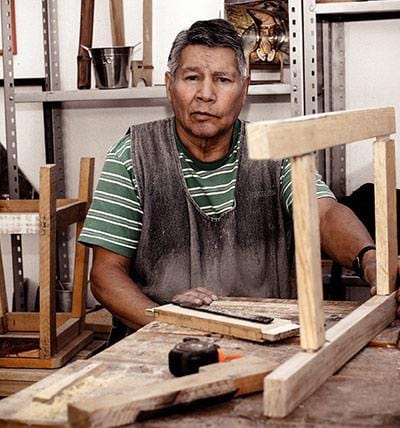If you're interested in building a violin, you should know that tonewoods vary greatly in their properties. A violin's wood should be from a tree that grows in the proper climate, seasoned properly, and has the right grain.
Read on to learn about maple, spruce, ebony, and rosewood violins.
Maple
Most modern luthiers use maple for the back, ribs, and neck of their instruments. Maple is prized for its unique figure, with alternating light and dark "flames."
Some luthiers use maple in favor of other woods, such as poplar and willow, which produce a darker tone. But what is maple's purpose in a violin? Let's take a closer look.
Most wood used for violins is cut in quarters, resulting in a long straight grain that won't warp. Some luthiers, however, choose to cut wood tangentially. For violins, maple is often cut on a slab, which highlights the flame of the wood and yields a deeper tone. Maple is also a popular wood for fingerboards.

Despite the low density of maple, it is still a preferred wood for violin bodies and sides. It is lightweight and resistant to gouges, and its color matches a spruce top well. It also retains its tone and playability under fluctuating humidity levels. However, it can be difficult to carve a violin made of this wood. The best woods for a violin's back, sides, and neck are made from maple, as opposed to spruce and ebony.
Spruce
The luthiers of old times used to spend days in search of a spruce tree that was ideal for making violins. These trees had fine growth rings and were free of knots, and they were located in a wind-sheltered cove in the Val di Fiemme. They were even willing to walk miles and spend nights in the woods in search of the perfect spruce for a violin.
The grain pattern of spruce wood determines its rigidity and sound production. The finer the grain, the less rigid and elastic the wood will be. That is why some contemporary makers recommend using pieces with a wider grain than those with a finer one. Wider grain spruce resonates better than pieces with a tight grain. A tight grain can cause harsh sounds. Spruce is a versatile wood that will last a long time.
Spruce is used as a top sounding board in violins, as well as for bass bars, sound posts, and corner/top/bottom blocks. It is also used for linings inside violins. These parts are important because they make the violin's structure more durable and transfer the sound more effectively throughout. The properties of this wood are also useful for violins' inner parts, like the ribs, bridges, and combs.
Ebony
If you're wondering why ebony is used in violins, consider the wood's history. Ebony is the collective name for the Diospyros species. Its heartwood is dense, hard, and black, sometimes flecked with gray. It was traditionally used to craft violin fingerboards, tails, pegs, purfling, mute, and ornamental elements.
The ebony tree takes around 100 to 200 years to develop fully. The timber is then carefully selected, and only 1 in 10 trees is suitable for cutting. The remaining trees are left to rot. Luckily, the violin industry is aware of the situation and has taken steps to minimize its destruction.
The material used to create violins is dense, and most string instruments have fingerboards made of ebony, boxwood, or rosewood. In addition to its rich color and smooth texture, ebony is popular as an ornamental wood. This rich wood also retains its texture over time, making it ideal for violins. So if you're considering purchasing a violin, ebony is a wise choice.
Rosewood
There are many types of wood used in making violins. Rosewood, for example, is a type of hardwood derived from tropical leguminous trees. Brazilian rosewood is primarily used for violin pegs and fingerboards. This wood has an average modulus of elasticity of two million pounds per square centimeter. It is also highly durable, making it an excellent choice for instrument makers.
Because it is a highly resonant wood, it takes a considerable amount of time to season. In fact, violin wood can take up to ten years to properly season, depending on its thickness and size. Ideally, a fifty-year-old rosewood violin should be used. Commercially dried lumber destroys the cell structure of the wood, affecting its physical and acoustic properties.
To produce the best sound, violins need dense wood. The most common hardwoods for this are ebony, rosewood, boxwood, and a variety of mahoganies. These woods are used for violin parts because they are dense and lightweight yet also offer a high level of resonant quality. However, if you can't afford this wood, you can always opt for rosewood or boxwood.

Poplar
This type is lighter in weight than American Maple, which allows the violin maker more flexibility in bending the violin and achieving optimal sound.
Maple logs are also characterized by flame patterns that develop in the trees. If the ripples match, the wood has an enhanced sound quality. The most popular maple species used in violin making is the Yugoslavian Maple.
Maple, along with poplar, is often used for the back of a violin. Maple's figure is one of its most prominent features. Poplar wood is less dense than maple, which increases the thickness of the violin back.
Mahoganies
While many types of wood are suitable for making violins, the best material for the violin's back is maple. Yugoslavian maple, for example, is considered the best maple because it is lighter than American maple. Maple's "flame" effect is caused by the wavy growth of fibers in the tree. The wood's light and dark "flames" appear in wavy patterns when cut, and the matching of these streaks is said to enhance the violin's sound quality.
The acoustic quality of a violin depends on the wood's density, and the thickness and width of the wood must be uniformly proportioned for the best sound. To achieve the best acoustic performance, wood should be evenly-seasoned, and fifty-year-old wood is the best. Commercial lumber that is dried in kilns destroys the cell structure and affects the physical and acoustic properties.
Mahogany can be used in the front, middle, and back of the violin. Its density and strength make it suitable for violins. However, mahogany is not the best choice for the back of a violin because it can't stand up to the pressure of the strings. If you want a violin with a richer sound, then mahogany might be a better choice.

Boxwood
Ebony, rosewood, and boxwood are all very dense hardwoods used in violins and other stringed instruments.
Each of these species is from different parts of the world. In addition to ebony, rosewood, boxwood, and certain mahogany can also be used in violin making.
This information should be kept in mind when choosing the material to use in your violin.
While it is not recommended to use untreated ebony for violins, seasoned ebony will last longer.
Both boxwood and spruce are used for violins, but boxwood is generally the best choice for the top. It has a high stiffness-to-weight ratio and is ideal for violins that feature higher-pitched strings. Compared to jujube, which is typically used for lining and internal blocks, boxwood is harder on the inside than jujube. A fine-quality boxwood violin is the most expensive of the two.
Violins made of boxwood are typically more expensive than their maple-made counterparts. The lower-quality varieties of the wood are commonly known as Brazilwood, while higher-quality variations are called pernambuco. Boxwood is typically stained black and is usually used as a fitting on beginner violin outfits. Snakewood is another option that is available and is not on any endangered species list. Because it is hard and dense, it is best for making violin bridges and chinrests.
Conclusion
There are many different types of wood that are used for violins, each with its own unique properties that make it suited for different purposes. The most common type of wood used for violins is spruce, which is typically used for the top, or soundboard. Spruce is a strong yet lightweight wood that has excellent acoustic properties, making it ideal for use in violins. Other common types of wood used in violins include maple and poplar. Maple is often used for the back and sides of violins, while poplar is often used for the neck and scroll. Each type of wood has its own unique grain pattern and color, which gives each violin its own unique appearance.
FAQ
What wood is a Stradivarius made of?
The wood that is used to make a Stradivarius is spruce. Spruce is a type of wood that is light in color and has a straight grain. It is a strong wood, which is why it is used for making musical instruments.

What makes a violin high quality?
There are many factors that contribute to the overall quality of a violin. The materials used, the craftsmanship, and the attention to detail all play a role in determining the quality of the instrument. The best violins are made with high-quality wood and other materials and are crafted with great care and precision. They are usually made by experienced luthiers who have a deep understanding of the instrument and how to produce a high-quality product.
What are expensive violins made out of?
Expensive violins are made out of high-quality wood, usually spruce or maple. They also have a high-quality varnish, which protects the wood and gives the violin a beautiful shine. The strings are made of gut or synthetic materials, and the bridge and soundpost are usually made of ebony. The best violins are made by hand, and the most expensive ones can cost up to $100,000.
ABOUT THE AUTHOR
Fred Felton
Content Creator / Editor
Fred Felton is a copywriter, editor and social media specialist based in Durban, South Africa. He has over 20 years of experience in creating high end content. He has worked with some of the biggest brands in the world. Currently Fred specialises in the wooden arts and crafts space, focussing on innovative wooden product design. He is also a keynote speaker and has presented talks and workshops in South Africa.






